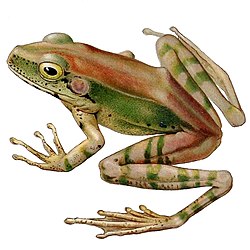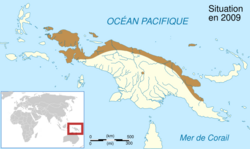Biology:Papurana papua
| Papurana papua | |
|---|---|

| |
| Scientific classification | |
| Domain: | Eukaryota |
| Kingdom: | Animalia |
| Phylum: | Chordata |
| Class: | Amphibia |
| Order: | Anura |
| Family: | Ranidae |
| Genus: | Papurana |
| Species: | P. papua
|
| Binomial name | |
| Papurana papua (Lesson, 1830)
| |

| |
| Synonyms[2] | |
| |
Papurana papua is a species of true frog, family Ranidae.[1][2] It is endemic to New Guinea and found in the northern part of the island in both Indonesia and Papua New Guinea as well in some offshore islands (including Normanby, Waigeo, and Manus Island).[1][2][3] Common name Papua frog has been coined for it.[2]
Description
Papurana papua is a comparatively small frog. Adult males grow to 60 mm (2.4 in) and adult females to 67 mm (2.6 in) in snout–vent length; mean length is respectively 56 and 64 mm (2.2 and 2.5 in). The limbs are short, giving this frog an oddly elongated appearance. The upper lip is white and contrasts with the surrounding dark ground color.[3] As typical for the genus,[4] dark post-ocular mask is present, but it is not clearly demarcated posteriorly. The sides have low-contrast pattern of brown clouded over white, gray, or faint yellow. The venter is white or with faint, dark yellow cast, evenly suffused with dark punctations or gray clouding. The dorsum is smooth or finely granular and has few, scattered, large, dark brown warts.[3]
The male advertisement call is a single pulsed note, sounding like a "quack".[3]
Habitat and conservation
Papurana papua lives in swampy forests and flooded grasslands, including disturbed habitats, at elevations up to 1,200 m (3,900 ft) above sea level. Breeding takes place in pools and swamps. It is an abundant and widely distributed species. No significant threats to it are known. It lives in some protected areas.[1]
References
- ↑ 1.0 1.1 1.2 1.3 IUCN SSC Amphibian Specialist Group (2020). "Papurana papua". IUCN Red List of Threatened Species 2020: e.T58691A152556063. doi:10.2305/IUCN.UK.2020-3.RLTS.T58691A152556063.en. https://www.iucnredlist.org/species/58691/152556063. Retrieved 19 November 2021.
- ↑ 2.0 2.1 2.2 2.3 Frost, Darrel R. (2017). "Papurana papua (Lesson, 1829)". Amphibian Species of the World: an Online Reference. Version 6.0. American Museum of Natural History. http://research.amnh.org/vz/herpetology/amphibia/Amphibia/Anura/Ranidae/Papurana/Papurana-papua.
- ↑ 3.0 3.1 3.2 3.3 Kraus, Fred; Allison, Allen (2007). "Taxonomic notes on frogs of the genus Rana from Milne Bay Province, Papua New Guinea". Herpetological Monographs 21 (1): 33–75. doi:10.1655/06-004.1.
- ↑ Oliver, Lauren A.; Prendini, Elizabeth; Kraus, Fred; Raxworthy, Christopher J. (2015). "Systematics and biogeography of the Hylarana frog (Anura: Ranidae) radiation across tropical Australasia, Southeast Asia, and Africa". Molecular Phylogenetics and Evolution 90: 176–192. doi:10.1016/j.ympev.2015.05.001. PMID 25987527.
Wikidata ☰ Q28051077 entry
 |


